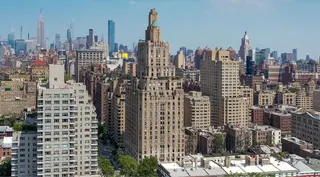 Carter Horsley
Carter HorsleyDec 23, 2011
Carter's Review
An isolated skyscraper, a rarity in Manhattan, One Fifth Avenue was one of the first Art Deco towers in the city and it dominates Lower Fifth Avenue, Washington Square Park and Greenwich Village.
Designed in 1927 by Helmle & Corbett with Sugarman & Berger, this is one of city's premier residential skyscrapers.
Its dark brown masonry and strong verticality make this tall setback tower quite monolithic.
The building, Christopher Gray noted in a 1992 article in The New York Times, "is one of the city's most illusionistic statements, where flat brickwork is made to appear three-dimensional through false shadow effects." The building that year completed a repair of its façades that gave the building, according to Mr. Gray, "an odd, spotty effect as the new horizontal ranges of brickwork clash with the old vertical detailing that was the basis of the false shadow effects." The four "turret-like corners" have a "false projection—darker vertical bands of brick look like shadows cast against the main wall" and "vertical, paired white and black brick stripes convincingly imitate angled masonry projections rising between the windows," Mr. Gray pointed out.
Harvey Wiley Corbett was a very influential architect of the early skyscraper age and, according to Robert A. M. Stern, Gregory Gilmartin and Thomas Mellins in their book, "New York 1930 Architecture and Urbanism Between The Two World Wars," (Rizzoli, 1987, "succeeded in overthrowing virtually all specific stylistic references in favor of a simple, naturalistic composition the most notable decoration of which came from the use of light and dark bricks to simulate shadows."
The authors quoted T-Square, a contemporary architectural journal, as noting that despite some "battlements, machiolations, pointed buttresses and various medieval suggestions..., this is thoroughly modern architecture." They also note that the "original design was a highly eclectic mixture of vaguely Venetian and French Romanesque details."
The building was developed by Joseph G. Siegel who leased the site in 1926 from Sailors' Snug Harbor, a charitable institution with considerable holdings in the area. The plan was for an apartment hotel of small units, each with a serving pantry for food brought up by service elevator from a central restaurant on the ground floor, Mr. Gray wrote.
The lower four stories of the building are covered in limestone and the building's large lobby is wood-paneled and traditionally attractive, with no hint of the more modernistic and stark, yet quite robust treatment of the tower's handsome façade. The building's prominent location between East 8th Street and Washington Mews, half a block from the Washington Arch, has made it a major landmark for the neighborhood.
The lobby's paneling recalls paneling that was in the Greek Revival house formerly on the site and the Gothic-style quatrefoil designs on the lanterns at the main entrance refer to the [Episcopal] Church of the Ascension's two blocks up the avenue, Mr. Gray observed.
An elegant and large restaurant and nightclub overlooking the attractive mews with its former carriage houses for the Greek Revival mansions, celebrated by Henry James, facing Washington Square Park has occupied much of its street-level space for a couple of decades. Its entrance is on 8th Street.
The façade has quite interesting limestone balconies with tubular form balustrades on the fourth floor and the building has many attractive terraces.
The 184-unit building was converted in 1986 to a cooperative.

- Co-op built in 1927
- 3 apartments currently for sale ($1.395M to $4.95M)
- Located in Greenwich Village
- 184 total apartments 184 total apartments
- 10 recent sales ($800K to $5.5M)
- Doorman
- Pets Allowed
 6sqft delivers the latest on real estate, architecture, and design, straight from New York City.
6sqft delivers the latest on real estate, architecture, and design, straight from New York City.
